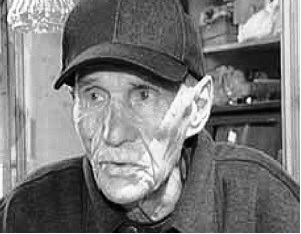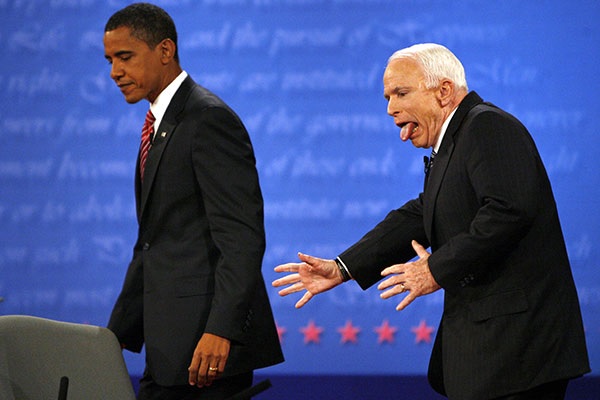As he
neared the target, warning systems in McCain's
A-4E Skyhawk alerted him that he was being tracked
by enemy
fire-control radar.[93]
He held his dive until he released his bombs at about
3,500 feet (1,000 meters)[94]
(he was later awarded the
Distinguished Flying Cross for this day).[88]
As he started to pull up, the Skyhawk's wing was blown
off by a Soviet-made
SA-2 anti-aircraft missile fired by the North
Vietnamese Air Defense Command's 61st Battalion.[89]
McCain's
plane went into a
vertical inverted spin.[95]
Bailing out upside down at high speed,[96]
the
force of the ejection fractured McCain's right arm
in three places, his left arm, and his right leg, and
knocked him unconscious.[96]
McCain nearly drowned after making a parachute landing
in
Trúc Bạch Lake in Hanoi; the weight of his equipment
was pulling him down, and as he regained consciousness,
he could not use his arms.[93]
Eventually, he was able to inflate his life vest using
his teeth.[93]
Several
Vietnamese, possibly led by Department of Industry clerk
Mai Van On, pulled him ashore.[97]
A mob gathered around, spat on him, kicked him, and
stripped him of his clothes; his left shoulder was
crushed with the butt of a rifle and he was bayoneted in
his left foot and abdominal area.[96][93]
He was then transported to Hanoi's main
Hoa Lo Prison, nicknamed the "Hanoi Hilton" by
American POWs.[98]
McCain
reached Hoa Lo in as bad a physical condition as any
prisoner during the war.[98]
His captors refused to give him medical care unless he
gave them military information; they beat and
interrogated him, but McCain only offered his name,
rank, serial number, and date of birth[99][100]
(the only information he was required to provide under
the
Geneva Conventions). Soon thinking he was near
death, McCain said he would give them more information
if taken to the hospital,[99]
hoping he could then put his interrogators off once he
was treated.[101]
A prison
doctor came and said it was too late, as McCain was
about to die anyway.[99]
Only when the North Vietnamese discovered that his
father was a top admiral did they give him medical care,[99]
calling him "the crown prince".[98]
Two days after McCain's plane went down, that event and
his status as a POW made the front pages of
The New York Times[80]
and
The Washington Post.[102]
Interrogation and beatings resumed in the hospital;
McCain gave the North Vietnamese his ship's name,
squadron's name, and the attack's intended target.[103]
(Disclosing this information was in violation of the
U.S. Code of Conduct, which McCain later wrote he
regretted, although he saw the information as being of
no practical use to the North Vietnamese.)[104]
Further coerced to give future targets, he named cities
that had already been bombed, and responding to demands
for the names of his squadron's members, he supplied
instead the names of the
Green Bay Packers'
offensive line.[103][105]
McCain
spent six weeks in the hospital,[91]
receiving marginal care in a dirty, wet environment.[106]
A
prolonged attempt to set the fractures on his right arm,
done without anesthetic, was unsuccessful;[107]
he received an operation on his broken leg but no
treatment for his broken left arm.[108]
He was temporarily taken to a clean room and interviewed
by a French television reporter whose report was carried
months later on
CBS.[109]
McCain was observed by a variety of North Vietnamese,
including Defense Minister and Army commander-in-chief
General
Vo Nguyen Giap.[110]
Many of
the North Vietnamese observers assumed that McCain must
be part of America's political-military-economic elite.[111]
Now having lost fifty pounds (twenty-three kilograms),
in a chest cast, covered in grime and eyes full of
fever, and with his hair turned white,[91]
in December 1967 McCain was sent to a prisoner-of-war
camp on the outskirts of Hanoi nicknamed "the
Plantation".[112]
He was
placed in a cell with
George "Bud" Day, a badly injured and tortured
Air Force pilot (later awarded the
Medal of Honor) and Norris Overly, another Air Force
pilot; they did not expect McCain to live another week.[113][114]
Overly, and subsequently Day, nursed McCain and kept him
alive;[114]
Day later remembered that McCain had "a fantastic will
to live".[115]
...McCain
and other prisoners were moved around to different camps
at times, but conditions over the next several years
were generally more tolerable than they had been before.[95]
Unbeknownst to them, each year that Jack McCain was
CINCPAC, he paid a Christmastime visit to the American
troops in
South Vietnam serving closest to the
DMZ; he would stand alone and look north, to be as
close to his son as he could get.[149]
By 1971,
some 30–50 percent of the POWs had become disillusioned
about the war, both because of the apparent lack of
military progress and what they heard of the growing
anti-war movement in the U.S., and some of them were
less reluctant to make propaganda statements for the
North Vietnamese.[131]
McCain was not among them: he participated in a
defiant church service[150]
and led an effort to write letters home that only
portrayed the camp in a negative light,[151]
and as a result spent much of the year in a camp
reserved for "bad attitude" cases.[131]
March
14, 1973 - Hanoi. John Sidney McCain III
was released in almost perfect condition, -
sic! -
not on
crutches
... he
being taken by bus to
Gia Lam Airport, transferred to U.S. custody, and
then flown by
C-141 to
Clark Air Base in the
Philippines
| September 14, 2008 | Фатех Вергасов - Fatekh Vergasov |
| John Sidney McCain III 35th enivesary of the meeting with President Nickson | |
|
October 26, 1967 - As he started to pull up, the Skyhawk's wing was
blown off by a Soviet-made
SA-2 anti-aircraft missile fired by the North Vietnamese Air Defense
Command's 61st Battalion.[89]
Mc — приставка в гэльских фамилиях, означающая "сын такого-то", например, McCain, etc. "Помню слова: "Джон Маккейн" Скончался советский ракетчик, сбивший самолет недавнего кандидата в президенты Соединенных Штатов  Ветеран
очень хорошо помнил день, когда он сбил самолет Маккейна 16 января 2009,
21:59 Ветеран
очень хорошо помнил день, когда он сбил самолет Маккейна 16 января 2009,
21:59Фото: Кадр канала "НТВ" Текст: Оксана Бутаева В пятницу в Санкт-Петербурге скончался Юрий Трушечкин. Бывший подполковник ракетных войск стал известен не так давно, когда признался, что принимал участие во вьетнамской военной кампании. Тогда же он рассказал, что лицо кандидата в президенты США Джона Маккейна ему знакомо. Выяснилось, что во время войны во Вьетнаме Трушечкин сбил самолет американского сенатора. Последние годы подполковник жил в ветхом домике недалеко от Петербурга. Долгое время Юрий Трушечкин страдал от онкологической болезни, сообщает "Фонтанка.Ру". Кавалер ордена Красной Звезды, полученного за выполнение интернационального долга во Вьетнаме, жил в старом домике на окраине Красного Села под Петербургом, где последние дни не было воды и тепла, на пенсию в 10 тысяч рублей и умер в ужасных условиях. "К счастью, он не стал президентом. Он ненавидел русских. Он знал, что его самолет сбила наша ракета" В ноябре прошлого года итальянская газета La Stampa рассказала историю Трушечкина. Он признался журналистам, что это именно он в 1967 году сбил самолет, в котором находился кандидат в президенты США Джон Маккейн. Ветеран узнал пилота, когда увидел в телерепортаже о кандидате в президенты США кадры, на которых сенатор от Аризоны был еще молодым военным летчиком. Подполковник Трушечкин, наблюдая за Маккейном по телевизору, радовался, что ему не удалось войти победителем в Белый дом. "К счастью, он не стал президентом. Он ненавидел русских. Он знал, что его самолет сбила наша ракета", – говорил ветеран.  Несмотря
на то, что до последнего времени русские не признавались, что
принимали участие в военной кампании, 70-летний Трушечкин убежден, что
скрывать, а тем более стыдиться ему нечего, сообщало издание. Он
рассказал, что попал во Вьетнам, будучи 28-летним капитаном, в то время,
когда там уже были смешанные подразделения с вьетнамцами. Служил
офицером наведения в ракетном расчете. А когда уезжал из Вьетнама, там
еще оставались около 70 офицеров, а также солдаты, пленных американцев
было 365 – как дней в году. Несмотря
на то, что до последнего времени русские не признавались, что
принимали участие в военной кампании, 70-летний Трушечкин убежден, что
скрывать, а тем более стыдиться ему нечего, сообщало издание. Он
рассказал, что попал во Вьетнам, будучи 28-летним капитаном, в то время,
когда там уже были смешанные подразделения с вьетнамцами. Служил
офицером наведения в ракетном расчете. А когда уезжал из Вьетнама, там
еще оставались около 70 офицеров, а также солдаты, пленных американцев
было 365 – как дней в году. День, в который был сбит самолет Маккейна, ветеран помнит хорошо. Капитан Трушечкин вместе с другими военными менял позицию ракетной установки, которая должна была прикрыть от американцев стратегический мост Хам Жонг. Военные уже уезжали, когда услышали сигнал воздушной тревоги и увидели, как подлетают два Phantom F-4. По цели были выпущены две оставшихся ракеты – остальные четыре были расстреляны раньше. Одна из оставшихся двух ракет из-за плохой наводки взорвалась в джунглях, а второй был сбит самолет. "Один самолет огибал холмы, а другой пошел прямо через мост. В него мы и стреляли", – рассказывал Трушечкин, который был офицером наведения. Летчик, которым, по словам Трушечкина, и был Джон Маккейн, катапультировался, и его взяли в плен вьетнамские солдаты. Как говорил ветеран, Маккейну повезло – обычно американских летчиков забивали мотыгами. Но Джона Маккейна отправили в страшную тюрьму, которую с сарказмом называли Hanoi Hilton. "Самыми ценными трофеями считались летный шлем и "флаг нищего" – нашивка с надписью: "Я американский гражданин, терплю бедствие, прошу оказать мне помощь" – на пяти языках, – вспоминал Юрий Петрович. – А в парашютной сумке нашли "корочку" серую. Это парашютная книжка оказалась. Я переводчика попросил посмотреть, что там написано. Помню слова: "Джон Маккейн". Парашют ему за день до этого собрали…" В качестве трофея капитан Трушечкин увез с собой домой документы летчика и фотографии, которые подпольно удалось сделать во Вьетнаме – фотографировать советским специалистам не разрешалось. При переезде Трушечкина из Риги под Петербург раритетный документ потерялся, остались только фотографии. "Тюремные охранники говорили, что он ненавидел русских. Если бы он стал президентом США, отношения между Россией и Америкой, несомненно, стали бы хуже", – убеждал в своем интервью ветеран. Как сообщают американские источники, 6 октября 1967 года Маккейн в составе эскадрильи из 20 самолетов вылетел на бомбардировку и был сбит. Летчик катапультировался и приземлился в озеро, он сломал обе руки и ногу и был жестоко избит вьетнамскими солдатами. На допросе он, в соответствии с американским военным уставом, назвал только краткие сведения о себе, по фамилии вьетнамцы установили, что они взяли в плен сына высокопоставленного американского офицера. Всего Маккейн провел в плену пять с половиной лет – 1967 дней – и был освобожден 15 марта 1973 года после подписания Парижских мирных соглашений между США и Вьетнамом. Добавим, что после этой публикации судьбой Юрия Трушечкина обеспокоились представители межрегиональной организации "Коммунисты Петербурга и Ленобласти". Они обратились к руководству страны и губернатору Петербурга с призывом наградить подполковника в отставке Звездой Героя России и назначить ему персональную пенсию. Кроме того, авторы обращения просили улучшить жилищные условия офицера и признать его почетным гражданином Петербурга. Еще до Нового года губернатор Петербурга Валентина Матвиенко выдала распоряжение отремонтировать дом подполковника. Однако помочь ему так и не успели. Оксана Бутаева Источник - Деловая газета "Взгляд" Разборы www.pseudology.org |
|